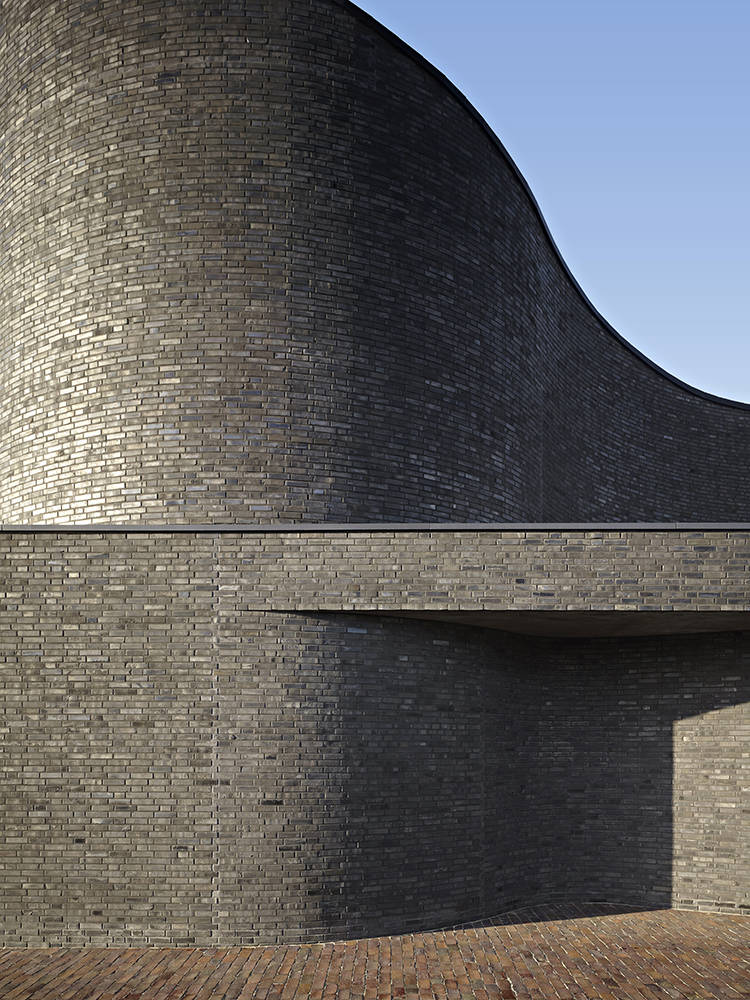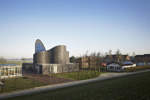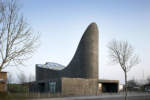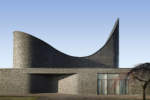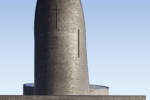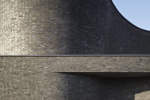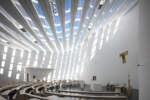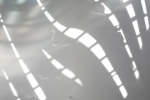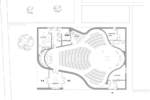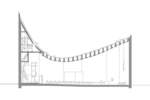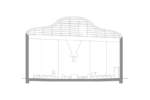architect: Königs Architekten
location: Schillig, Germany
St. Mary’s Seashore Church is situated directly on Germany’s North Sea coast, separated only by a dyke from the Unesco World Natural Heritage Site of the Wattenmeer mudflats.
A bird’s eye view reveals the simplicity of the spatial topology: a classical cruciform plan inscribed on a rectangle. The rectangular frame forms – and is confined to – the base of the building; above it the cruciform shape of the main church space is clearly visible. The external impact of the building, in other words, already contains the key to deciphering the simplicity of its complexity.
However, the straightforward extrusion of a rounded cross from a rectangular base would hardly justify the formal concept.
The development of formal complexity from the simple plan depends decisively on the excision of a broad curvilinear wedge cut, as it were, in a single downward and upward sweep out of the cruciform body of the church. The result is a surprising multiplicity of forms. The term ‘cut’ must be understood as referring to a quasi-Boolean process of architectonic conception. The three determinant elements of the building – (a) rectangular base, (b) cruciform space, and (c) curved cut – create an emergent complex of space and mass that refers both to the received typology of the church and to the local environment of the sea. Interestingly, the readability of the simple forms generates a sense of natural relationship, but those same forms achieve a multifaceted and by no means univocal level of abstraction that opens them out to the observer’s personal images and associations.
The walls of the Seashore Church are not made of monolithically rendered masonry but consist of a load-bearing concrete shell separated by a layer of insulation from an outer skin of brick. This method was chosen not only to ensure optimal insulation but also, in this case, to set the exterior of the building apart from the interior in the materials used. For the external walls so-called Oldenburg bricks (220 x 105 x 52 mm) with a density of 20 kN/mc – a very hard material suited to the extreme weather conditions of the North Sea coast – were laid in Danish bond, a pattern that approximated local usage while not imitating it and that supported the specific geometry of the building. Brick has been used for centuries, and there may seem some contradiction in making complex demands of so simple and traditional a material. The bricks were fired a second time, although from a purely technical point of view they were ready for use after the first firing. A single firing, however, would not have given them the extreme strength and special finish necessary for adequate support of the building’s geometry.The second firing used an elaborate traditional procedure, nowadays almost forgotten, in which extrinsic oxygen is excluded from the oven and, as a result, the firing extracts the oxygen inherent in the material. Instead of getting the typical red-brown colour the brick turns black and takes on a blue-green, or sometimes even silver sheen like a piece of gleaming iron, and salt deposits may crystallize on the surface. The emergent process is hard to control and not predictable in every detail, but it generates the additional qualitative values that enable the material to play a central architectonic role in the building.
A further level of emergence is apparent in the roof construction and incidence of light. The surface created by the Boolean operation described above is both monoaxially curved and inclined, as if a hot knife had sliced through butter – a simple cutting action that immediately generates a complex geometry of edge, line and surface, with all the ensuing constructional problems. The surfaces thus generated were fully glazed, but – as with the second firing of the bricks – a further action was necessary to achieve the complexity of light desired for the interior. This action consisted in allowing the struts spanning the roof space to taper toward the middle and then broaden again, instead of remaining linear. And the strategy itself was not applied in a linear fashion either: it culminated at the central point of the cruciform and gradually diminished toward the extremities of the nave.
The generative process of roof and ceiling structures aimed to achieve a dynamic, changing
pattern of light and shade throughout the day and year. Light entering from the glass roof passes through the gradually widening curved spaces between the struts and falls on the smoothly curved interior walls – a geometrical superscription of two curved surfaces standing at right angles to each other. The resultant pattern of dynamically distorted wave-bands of light determines the atmosphere within the church. The decisive point, however, is that the observer cannot, without precise analysis of the situation, trace the origin of the phenomenon. In the ideal case he or she will not even try to but, as in a Baroque counterpart, will simply enjoy the emergent impressions of a ‘Seashore Church‘ without
asking from what, and in what genetic process, they arise.


